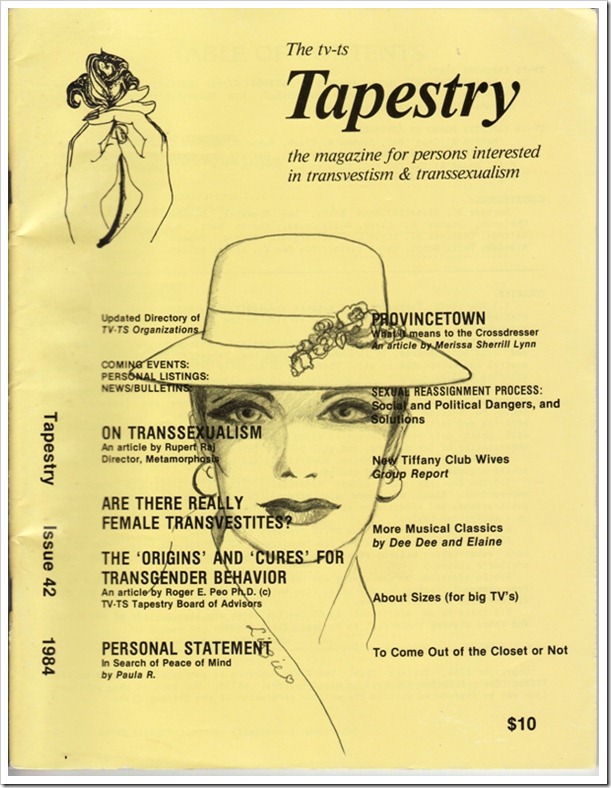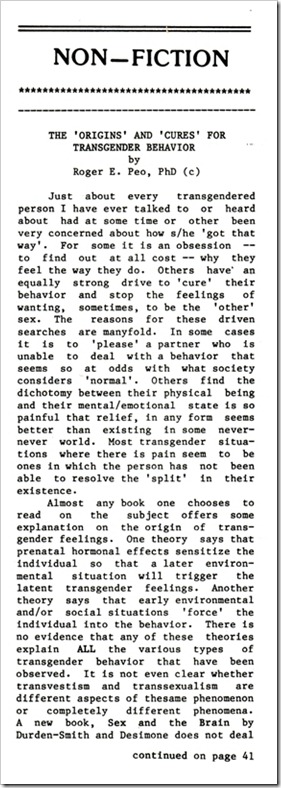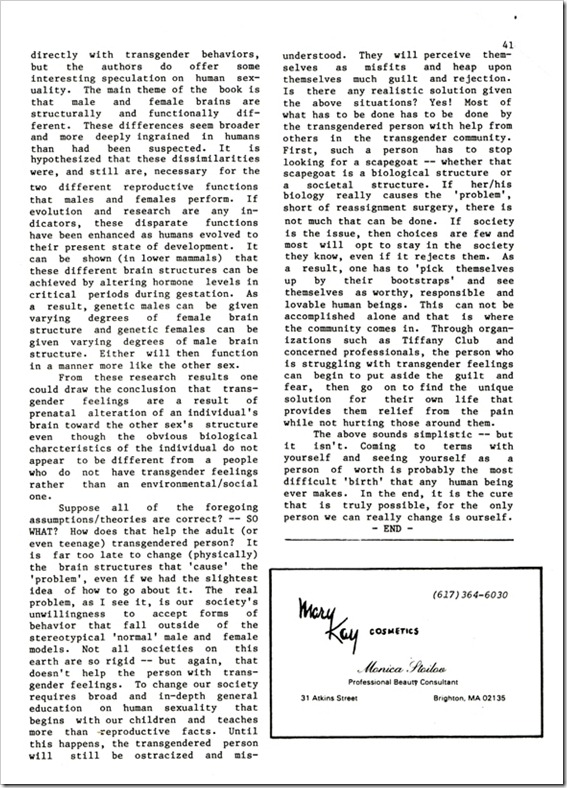As many of you know by now, I’ve recently been interested in uncovering never before considered historical records relating to how the term “transgender” evolved over the years.
One often-cited source, claims:
As far as we can see, Virginia first used the term ‘transgenderal’ in print in 1969. She does not seem to have used the term in print again. In 1978 she changed the term to ‘transgenderist’ and this then became her preferred lexical compound of the ‘trans- ‘ + ‘gend-‘ type.
Now it is important to grasp that Virginia is a forthright lady. She considers her usage to be consistent, clear and necessary. Those of us who don’t agree with her have ‘got it wrong’! Theoretically, she is convinced that her sharp distinction between sex and gender is correct. She considers any other use of the term ‘transgender’ to be confused, confusing or wrong.
We agree that her usage is consistent, although on a personal level she seems to have found it difficult to maintain the strict separation between sex and gender – notably in regard to her female hormone intake and breast development. However, to us, the significance and importance of her position lie in its consequences.
– Dr. Richard Elkins, 2004
As a recent article I wrote for the Bilerico Project demonstrably proves, multiple sources were using derivations (or perhaps independently constructed? – could someone research please?) of the term Virginia is credited for creating. Dr. Elkins states that “transgenderal” evolved into “transgenderist” in 1978.
As I’ve shown, the term “trans-gender” was used in the following ways:
-
1975, the term is used to refer to rock star Alice Cooper (1)
Additionally, the term “transgender” was used in the following ways:
-
1971, the term is used in theatrical circles (7)
- 1974, the term is used to refer to transsexual surgery (8)
- 1975, linguist uses the term in reference to non-gender specific pronouns (9)
- 1982, author of scientific paper assumes reader to be familiar with term (10)
Lastly, the term “transgendered” was used in the following way:
Until recently, those engaging in the debates about the term “transgender” have never had the opportunity to consider the above historical records or their implications.
Today while rooting around in the Transgender Archive, I found a new source that is germane to the generally accepted narrative of the term’s etiology.
Consider the following:
The TV-TS Tapestry, 1984
Consider the context with which the terms “transgender” and “transgender community” are used in this 1984 trans community article:
The ‘Origins’ and ‘Cures’ for Transgender Behavior
by Roger E. Peo, PhD
Just about every transgendered person I have ever talked to or heard about had at some time or or another been very concerned about how s/he ‘got that way’. For some it is an obsession – to find out at all cost – why they feel the way they do. Others have an equally strong drive to ‘cure’ their behavior and stop the feelings of wanting, sometimes, to be the ‘other’ sex. The reasons for these driven searches are many fold. In some cases it is to ‘please’ a partner who is unable to deal with a behavior that seems so at odds with what society considers ‘normal’. Others find the dichotomy between their physical being and their mental/emotional state is so painful that relief, in any form seems better than existing in some never-never world. Most transgender situations where there is pain seem to be ones in which the person has not been able to resolve the ‘split’ in their existence.
Almost any book one chooses to read on the subject offers some explanation on the origin of transgender feelings. One theory says that prenatal hormonal effects sanitize the individual so that a later environmental situation will trigger the latent transgender feelings. Another theory says that early environmental and/or social situations ‘force’ the individual into the behavior. There is no evidence that any of there theories explain ALL the various types of transgender behavior that have been observed. It is not even clear whether transvestism and transsexualism are different aspects of the same phenomenon or completely different phenomena. A new book, Sex and the Brain by Durden-Smith and Desimone does not deal…
… directly with transgender behaviors, but the authors do offer same interesting speculation on human sexuality. The main theme of the book is that male and female brains are structurally and functionally different. These differences seem broader and more deeply ingrained in humans than had been suspected. It is hypothesized that these dissimilarities were, and still are, necessary for the two different reproductive functions that males and females perform. If evolution and research are any indicators, these disparate functions have been enhanced as humans evolved to their present state of development. It can be shown (in lower mammals) that these different brain structures can be achieved by altering hormone levels in critical periods during gestation. As a result, genetic males can be given varying degrees of female brain structure and genetic females can be given varying degrees of male brain structure. Either will then function in a manner more like the other sex.
From there research results on could draw the conclusion that transgender feelings are a result of prenatal alteration of an individual’s brain toward the other sex’s structure even though the obvious biological characteristics of the individual do appear to be different from people who do not have transgender feelings rather than an environmental/social one.
Suppose all of the foregoing assumptions/theories are correct? – SO WHAT? How does that help the adult (or even teenage) transgender person? It is far too late to change (physically) the brain structures that ‘cause’ the ‘problem’, even if we had the slightest idea of how to go about it. The real problem, as I see it, is our society’s unwillingness to accept forms of behavior that fall outside of the stereotypical ‘normal’ male and female models. Not all societies on this earth are so rigid – but again, that doesn’t help the person with transgender feelings. To change our society requires broad and in-depth general education on human sexuality that begins with our children and teaches more than reproductive facts. Until this happens, the transgender person will still be ostracized and misunderstood. They will perceive themselves as misfits and heap upon themselves much guilt and rejection. Is there a realistic solution given the the above situations? Yes! Most of what has to be done has to be done by the transgendered person with help from others in the transgender community. First, such a person has to stop looking for a scapegoat – whether that scapegoat is a biological structure or a societal structure. If her/his biology really causes the ‘problem’, short of reassignment surgery, there is not much that can be done. If society is the issue, then choices are few and most will opt to stay in the society they know, even if it rejects them. As a result, one has to ‘pick themselves up by their bootstraps’ and see themselves as worthy, responsible and lovable human beings. This can not be accomplished alone and that is where the community comes in. Through organizations such as the Tiffany Club and concerned professionals, the person who is struggling with transgender feelings can begin to put aside the guilt and fear, then go on to find the unique solution for their own life that provides them relief from the pain while not hurting those around them.
The above sounds simplistic – but it isn’t. Coming to terms with yourself and seeing yourself as a person of worth is probably the most difficult ‘birth’ that any human being ever makes. In the end, it is the cure that is truly possible, for the only person we can really change is ourself.
Questions:
-
Note the way in which the author assumes that the reader understands the term; is it significant that in 1984 the author assumes that the definition of “transgender’” is already fully formed the the reader’s mind?
-
How do the ideas of this 1984 article mirror ideas found within the “transgender community” today?
-
In what way does this historical record fit the historical narratives favored by some in the TS separatist movement?
-
Might one consider this article representative of one branch in the term’s evolutionary process?
Note the variant uses of the term:
-
Transgender community
-
Transgender feelings
-
Transgendered person
-
Transgender behavior
Note that the author seems to be using the term in a way that is generally thought to exist only in the post-1990s era:
There is no evidence that any of there theories explain ALL the various types of transgender behavior that have been observed. It is not even clear whether transvestism and transsexualism are different aspects of the same phenomenon or completely different phenomena.
The author seems to be using the term “transgender” to refer to all the constituent groupings captured under the “transvestism and transsexualism” taxonomy. Is this particular context from 1984 represented in the way the term is generally used today?
Chronological and Etiological Considerations
From whence comes the word “transgender”?
- Dr. Richard Elkins dates the creation of the word “transgenderist” at 1978
- Webster dictionary dates the word “transgender” at 1979
- Dictionary.com dates the word “transgender” at “1990-95”
How do these official reference points reflect the historical record? My research shows that as early as the year 1970 the term was used by non-trans news media to describe a movie about a supposed transsexual. Knowing this, is it still appropriate to claim that Virginia Prince coined the term?
Consider the following from an article in which Prince is interviewed:
In her view, if you’re not a transsexual, you’re a transgenderist – a term she coined and uses to identify herself. In fact, she considers sexual reassignment surgery a mistake for anyone, and doesn’t really understand one’s identification with transsexuality.
Additionally, the incredibly informative website “A Gender Variance Who’s Who” states:
It is sometimes said that Prince coined the term ‘transgender’. What she actually coined was ‘transgenderist’ for a heterosexual transvestite who goes full time. This is by structure and by meaning significantly different from the word ‘transgender’ which we now use.
It is obvious that Prince’s use of her 1978 (Can anyone corroborate/disprove Dr. Elkins’ date through another source please?) word is not consistent with the way the media used the term in 1970, how it was used by in theatrical circles in 1971, how it was used by the medical community (to refer to transsexual surgery) in 1974, the way linguists used it to reference non-gender specific pronouns or the way it was used to describe a gender-atypical rock star in 1975, or the way a post-op transsexual woman used it in 1979. Did the term truly originate with Prince or is it more accurate to state that Prince’s word “transgenderist” was perhaps only one evolutionary branch of the term’s actual etiology?
Historical Document Disclaimer:
As I continue to publish historical documents relevant to the debates going on around the term transgender, I will include this disclaimer in hopes that it will cut down on having my position strawmaned to death.
The ideas found within the transgender community came from somewhere; they didn’t magically pop into existence on January 1, 1990. My intent in making these historical records accessible is to dispel some historical inaccuracies some within the TS-not-TG group popularize. I continuously find ideas that are purported to have originated within the so-called “transgender Borg”/“slave master” community sometime in the early 1990s and which was then supposedly thrust upon an unsuspecting transsexual community were in fact, championed by transsexuals and others prior to 1990.
I find that I agree with practically everything those in the moderate TS-not-TG group assert with only one major exception: Many assert that the “transgender umbrella” idea doesn’t refer to a group of unique allies who find unity in a common cause. In fact, most transsexuals do not feel that the we should be segregated away from all of our allies in our continued fight for equality and, as these historical record continue to reveal, transsexual people of history did not seem to have a need to rip the transsexual community away from other communities to go it alone.
For a view that very closely resembles my own views on this issue, check out The Death of the “Transgender Umbrella” by Mercedes Allen. My reservations about this article are summed up nicely within the comment section by Dr. Jillian Weiss:
Great article, but you can’t create a movement to “not be transgender.” Critique is valuable, but by itself, it can only alter an existing movement, not build one of its own. Movements have to be for something. If we could create a viable “transsexual movement,” I’m for it. But it is unlikely that such a movement can occur at this point in time. Very unlikely. Although I agree with the idea on a theoretical basis, I don’t think it will ever go beyond talk.
So, if you take Allen’s article and combine it with what Weiss had to add, you’d have a near perfect representation of my views about the TS-not-TG debate.



Leave a Reply
You must be logged in to post a comment.